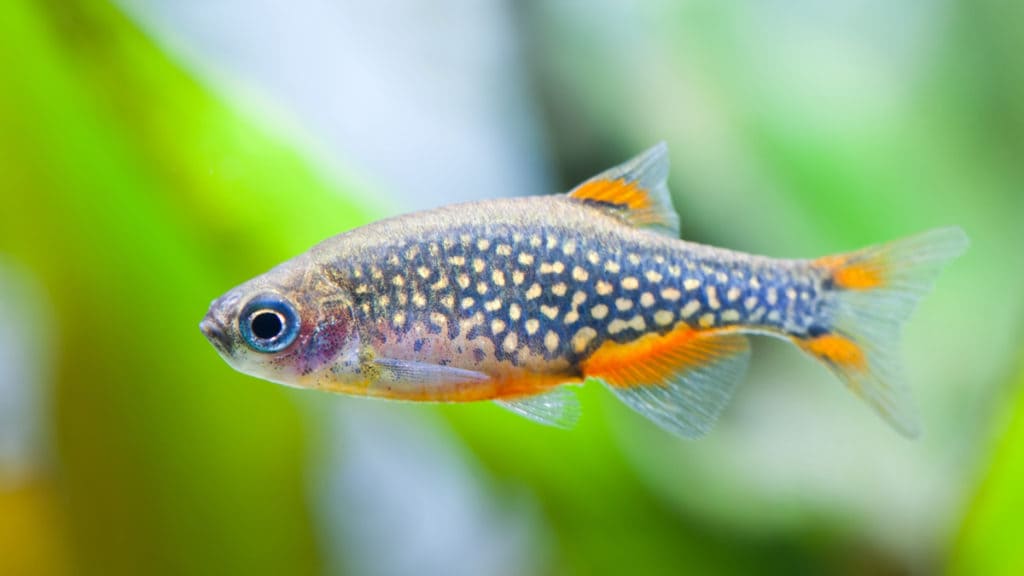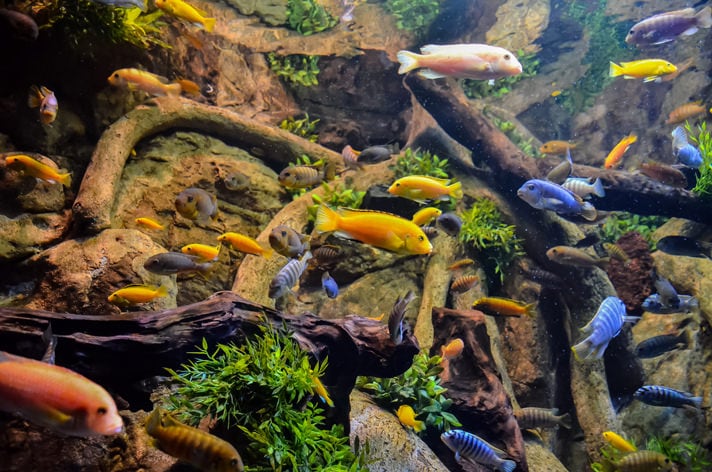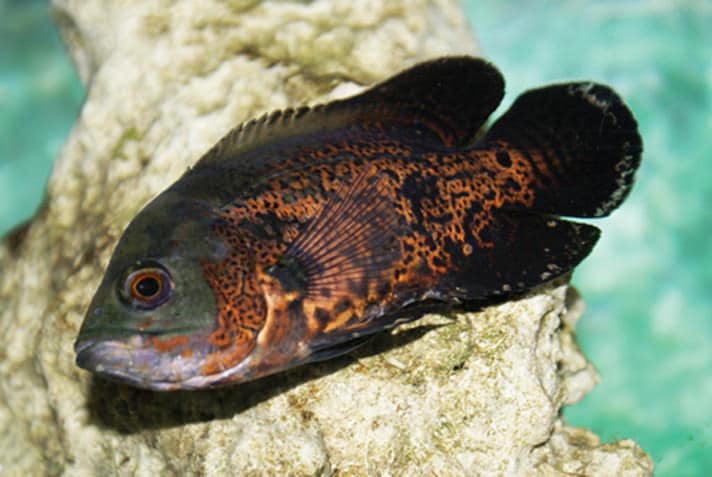Imagine peering into an underwater garden teeming with colorful plants, leisurely swaying in the gentle current. A tiny sparkle captures your attention as your eye travels down a gap in the lush vegetation of this Dutch-style planted aquarium. Slowly, the tiny glimmer develops into a strikingly beautiful miniature fish known as the celestial pearl danio.
Read More
Breeding the Celestial Pearl Danio
The celestial pearl danio (Danio margaritatus) originates from Myanmar and Thailand, where it has long has been considered a food fish and are sold as a protein snack. Its use dramatically changed in 2006, when previously restricted areas of the country were opened for exploration. Aquarium fish collectors soon discovered this magnificent miniature danio and immediately began exportation.
The ensuing collection and exportation frenzy, reminiscent of the California Gold Rush, apparently diminished the fish’s population to such low levels that fears of exploitation and pending extinction prevailed. The over-fishing concerns proved unfounded as the rapidly reproducing fish continue to populate its native wetlands. Areas thought completely devoid of the fish have reportedly rebounded in about one year, reflecting the quick ability of this species to regenerate. Additionally, captive breeding has greatly eased the demand for wild-caught specimens.
The celestial pearl danio has provided a breath of fresh air to the aquarium hobby. We might have to go back as far as the discovery of the neon tetra (Paracheirodon innesi) to find such enthusiasm for a newly introduced species.
This tiny freshwater fish clearly rivals the beauty of many saltwater fish. As result, unprincipled or uninformed retailers and companies could inflict irreparable damage on the tropical fish hobby in an attempt to turn a quick profit. Marketing these fish for pint-sized designer tanks for “the executive desk” could be one such gimmick.
Consumers purchasing such items are unlikely to be informed about the proper care of tropical fish, leading to disappointment. These are not fish for a beginner. If you are new to the hobby, I urge you to please seek the assistance of an experienced hobbyist or your local fish store prior to obtaining these marvelous fish. The celestial pearl danio, often referred to as CPD for short, is a joy to keep in the care of an experienced hobbyist.
Earlier, I mentioned that the CPD is perfect for a small aquarium. An ideal nano aquarium comprises from 10 to 12 gallons. Tanks this size are spacious enough to compassionately house a small school of CPDs and allow for adequate filtration, heating and lighting systems capable of growing live plants. Live plants are an essential ingredient for their comfort.
One of my goals is to always present material that can be replicated by a hobbyist with average fishkeeping ability. As such, the nano aquarium featured is easily obtained and relatively inexpensive. The tank setup and operation is exactly as presented unless otherwise noted.
Tank Setup
I selected a 10-gallon fish aquarium because they are very inexpensive, and I keep a bunch of them for breeding and propagating aquatic plants. A 10-gallon aquarium is an excellent choice for keeping CPDs on a budget. With dimensions of 20 inches long, 10 inches wide and 12 inches high, this tank doesn’t require vast amounts of expensive substrate (gravel) and can be filtered and heated for quite less than a larger tank. With live plants, I suggest using a plant-specific lighting system, such as the Marineland Plant LED.
A 1-inch sheet of Styrofoam was cut to the dimensions of the tank’s base. I always use a sheet of Styrofoam under my tanks to help prevent stress cracks in the event the stand flexes. The Styrofoam also creates a thermal barrier which holds heat inside the tank. Some hobbyists think plants might grow better with the thermal barrier but this is conjecture. Certainly, it can’t hurt. Place the Styrofoam sheet on the stand, carefully position the empty aquarium on the sheet and use black electrical tape to hide the sides of the Styrofoam.
About 25 pounds of plant-specific, black fluorite substrate covers the tank’s floor, with an average depth of approximately four inches. Black was chosen because of the striking contrast it creates with the celestial pearl danios. Fluorite is also an excellent choice for growing aquatic plants. Fluorite, as any gravel, contains small particles that will cause cloudy water unless it is well-rinsed prior to introduction into the aquarium.
As far as aquascape goes, keep in mind that CPDs are skittish and tend to hide. Provide plenty of large rocks or logs for them to seek refuge. Position these items so that when the fish do nestle, you can still view them. The featured tank seen in the pictures here has logs on each side, with plants attached. In the mid-section sit chunks of Arkansas quartz.
I use dual filtration, which consists of a hang-on-the-back, 200-gallon-per-hour power filter. CPDs love swimming against the current of the power filter. The second filter is an air-pump-driven, single-sponge fish tank filter. I use sponge filtration in all of my aquariums, regardless of size, because of their tremendous biological filtering capability. The tiny organisms growing all over the sponge make tasty meals for fish and crustaceans.
A submersible heater keeps the aquarium at 75 degrees Fahrenheit. The heater is vertically mounted on the back about two inches from the side, which allows sufficient water circulation and heat dispersion. With vague information about the CPD natural habitat, no one really knows the ideal temperature range for these fish. Other hobbyists report that CPDs seem to be fine with a temperature range from 70 to 77 degrees.
My tank was initially filled about half full with dechlorinated water and planted with live aquatic plants. I chose to make this a low-technology aquarium (no CO2 is added to the water) and selected easy-to-grow plants. CPDs originate from shallow, planted pools, only a foot or so deep. Understandably, to avoid predation, they normally do not swim at the water’s surface.
The plants selected are taller-growing and floating to provide overhead coverage and a sense of security. I chose to make this a very lightly planted aquarium to maximize viewing (and photo opportunities) of the small fish. More plants will be added in the near future. Following planting, I added the remaining water and activated all life-support equipment (filters, heater, lighting).
The tank was established a full six-weeks prior to the arrival of the CPDs. The six-week period allowed sufficient time for the completion of the new tank nitrogen cycle, making the aquarium ready for immediate occupancy when the CPDs arrived. To accelerate the cycling process, a liter measuring cup full of black fluorite from another well-established tank was scattered across the tank’s substrate just prior to planting the aquarium. This process is called “seeding,” and it introduces beneficial bacteria to a new aquarium.
Additionally, the sponge filter and power filter insert were also taken from other well-established tanks. Finally, a live-bacteria culture was added to the tank. The live-bacteria culture, fluorite seeding, seasoned sponge filter, power filter insert and live plants made for a shortened cycling process. Two white cloud mountain minnows (Tanichthys albonubes) happily lived in the tank before the arrival of the CPDs so that the tank could become established. The white clouds were re-homed just prior to introducing the CPDs because I wanted a species tank. A cherry red shrimp was added for color and interest. The shrimp and CPDs coexist beautifully.
Acquiring Celestial Pearl Danios
One might think that such a pretty fish would be readily available, but sadly, this is not the case. In fact, even my favorite, locally owned pet shop, which has specially ordered all sorts of odd fish for me over the years, was not able to reasonably acquire the dozen or so I needed. I reached out to growers, shippers and anyone else who might be able to supply the fish, but had absolutely no luck. Here is why: Pet shops would have to place an order of between 300 to 600 to obtain the fish. My pet shop told me the fish are so small that, when full-grown, there just really isn’t any demand.
Luckily, a source was discovered in California from Bob’s Tropical Plants. Mail ordering from them was easy and their customer service was excellent. The fish arrived ahead of schedule and in better condition than I expected. Thanks to wide-scale captive breeding, CPDs are now quite inexpensive. My CPDs were pond raised in Asia and cost $3.50 for each fish, which is a good price. The fish were shipped as juveniles and lacked the spectacular coloration that they now display upon reaching maturity.
Care and Observations
After introduction into the aquarium, the CPDs were disorganized and swimming and resting as individuals. But order seemed to appear in about a day, as a group, using a log or large plant for a safe haven. They finally decided to gather in a rather small space between the sponge filter and java moss. At night, this is where they all rest. During the daylight hours, when startled, they form into a group and dart directly to this retreat. The CPDs swim throughout the tank but seem to spend most of their time in the bottom third of the tank’s depth. Their danio-like social behavior involves chasing one another, foraging for food and swimming into the filter’s current.
Interestingly, they also seem perfectly happy being alone. It is not unusual to find females swimming around plants for an extended time, seemingly ignoring the presence of the other fish. That, of course, changes when a male appears. Two of my 12 CPDs are male. Hobbyists report that the males flare their fins and quarrel with each other, especially when courting a female. I have not yet noticed this behavior, even after observing them for many hours. Perhaps the lack of competition is due to the low-male-female ratio and the spaciousness of the planted aquarium.
Feeding the juvenile CPDs took some creativity. They are omnivores with petite mouths. Originally, finely ground fish food received a tepid welcome, possibly because this was their first exposure to a prepared food. Switching to newly hatched brine shrimp and micro worms quickly solved that problem. CPDs have a voracious appetite when presented with live foods, especially daphnia. After a couple of weeks, they were large enough to eat Hikari Micro Pellets, which they readily accepted. They now receive a diet of micro pellets, ground flake food and live food, such as daphnia, brine shrimp and micro worms. CPDs prefer to capture their prepared food while it is in suspension or slowly falling in the tank. They will reluctantly eat from the gravel bed, depending on how hungry they seem to be. One exception is if live foods fall into the substrate; they will enthusiastically eat from the bottom.
Partial water exchanges (25 percent) are conducted weekly. Other than neutralizing chlorine and chloramines, nothing is done to alter the tap water. The pH is 7.5 and KH 12, and the fish are clearly happy as indicated by their willingness to breed like there is no tomorrow. A very strange observation involves at least one (perhaps both) males occasionally swimming to the water’s surface and taking a gulp of air. It is similar to the behavior of a Corydoras spp.
Attractive and Engaging
I think celestial pearl danios would be an excellent choice for Dutch-style planted aquariums. Just imagine the beauty of these aquatic jewels meandering along the planted avenues of such a glorious underwater garden. In a Dutch-style planted aquarium, the plants, rather than the fish, are the main theme. For years, those keeping these unique tanks searched for small fish to complement their displays. Enter the celestial pearl danio! A peaceful, colorful tropical fish that remains small.
Celestial pearl danios are enormously beautiful and easy to keep. They are a true conversation piece and will bring hours of viewing entertainment to your family. Hopefully, as seen with the neon tetra, the celestial pearl danio will, eventually, become a commonly stocked species at your local pet shop. This will become a reality through hobbyists like you, who will take the challenge to breed and trade the offspring. I wish you aquarium success!
By: Stephen G. Noble
Featured Image: Besjunior/Shutterstock.com
Share:










